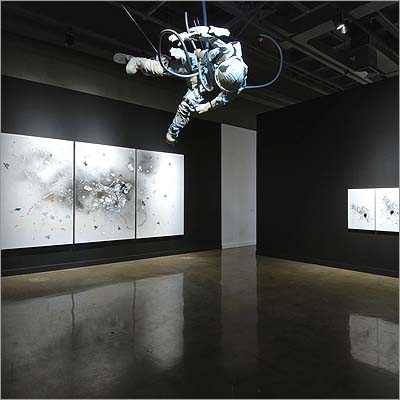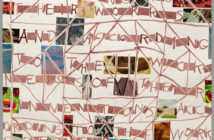Tavares Strachan is perhaps best known for a sculptural project called The Distance Between What We Have and What We Want (Arctic Ice Project). It is essentially a refrigerated block of Arctic river ice, with electricity provided by solar power. The sculpture, weighing almost five tons, was initially shipped to Nassau in the Bahamas before making the rounds at Art Basel Miami and then several sites in New York City, somewhat mitigating the implied conservation themes of the work -- or reinforcing them, depending on how you view such things. In the Bahamas, the piece was apparently used as a teaching tool, in New York, it became sculpture again.
Bahamas-born Strachan is a post-colonial fabulist, an artist/mad scientist who conjures up a world of sugar cane-fueled glass rockets and space exploration. He also has an interest in forming an ocean and aerospace exploration agency in the Bahamas, out-sized ambitions--even for the art world. But oddly enough, this is what is intriguing about Strachan’s work. His overreaching is almost comic, co-opting the Yuri Gagarin Cosmonaut Training Center in Russia and various departments at MIT itself, where the artist had a residency. There’s a Victorian grandeur to his work reminiscent of numerous explorers who set out on flamboyant and sometimes self-serving journeys that once were thought impossible, as indeed many were.
Whether or not Strachan’s conceptual systems are to be taken with a grain of salt is hard to tell. This interdisciplinary caterwauling between art and technology is a difficult trick to pull off, yet the videos in “Orthostatic Tolerance: It Might Not Be Such a Bad Idea if I Never Went Home” attest to Strachan’s experiences and add a veneer of scientific luster and gee-whiz gadgetry to his work. The videos have elements of the Chuck Yeager biopic The Right Stuff combined with a low-budget science documentary. Whether training with Russian scientists or diving with underwater experts at MIT, the exhibition has a Dr. Who-like curiosity.
And to a large degree, that curiosity is centered on “pressure”-- namely the forces exerted on the body underwater or in space -- to which “Tolerance” in the show’s title refers: A hand-blown glass diver is submerged in 900 gallons of mineral oil and floats almost invisibly in an enormous tank. An astronaut is shattered, blown apart in the space above the viewer’s head, dangling just moments before what’s recognizable explodes off into the cosmos. There are three painted panels that, while echoing the theme, are weak depictions of the space traveler’s fate. And glass rockets fueled by sugar cane go soaring off before landing in the ocean, snugly netting most of Strachan’s fixations in one fell swoop. Simple, yet intoxicating.
The toggling back and forth between biography and experimentation is a nagging problem for the artist and the three school desks sculpted from chalk and named for three noted Bahamian educators exemplify this issue with the disappointing simplicity of a public monument. In passing, one learns that 80 percent of the Bahamas is composed of chalk. In Duplicated Buggy Crash two identical Piaggio Apes (small 3-wheeled vehicles) are arrayed facing each other, each with identical damage from an imagined collision. What Strachan is suggesting with this work is unclear, and the buggy crash feels staged, as of course it was, and lacking any cohesion or resonance with Strachan’s other madcap endeavors. The shifting between self and whimsy in his body of work is an understandable distraction for an artist who is metaphorically always returning home, perhaps even while he dreams of eventually leaving the planet.
Tavares Strachan: Orthostatic Tolerance at MIT's List Visual Art Center.
"Orthostatic Tolerance" is on view through July 11.
All images are courtesy of the artist and MIT's List Visual Art Center.
A flickr set of Tavares' Arctic Ice Project at the Brooklyn Museum.




